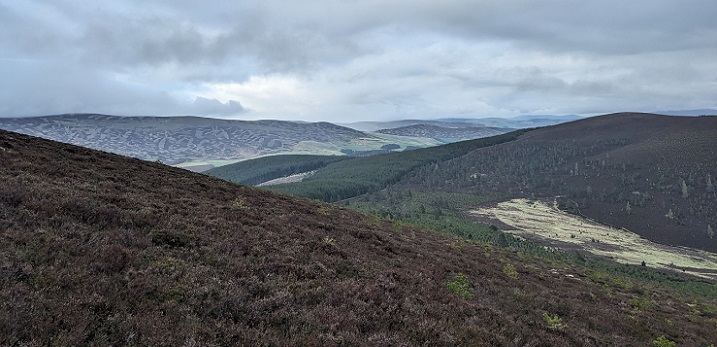
One evening three weeks ago I went up Ladylea Hill at the northern end of the Candacraig Estate. While the predominant land use in most of the upper catchment of the River Don is intensive grouse moor management, much of Candacraig has been used for commercial forestry for some time and the main “sporting use” is pheasant shooting.
Ladylea Hill and the land to the south still appears on many maps as a gap in the forestry but in 2013 the Candacraig estate was awarded a grant from Scottish Forestry to plant it with native woodland.
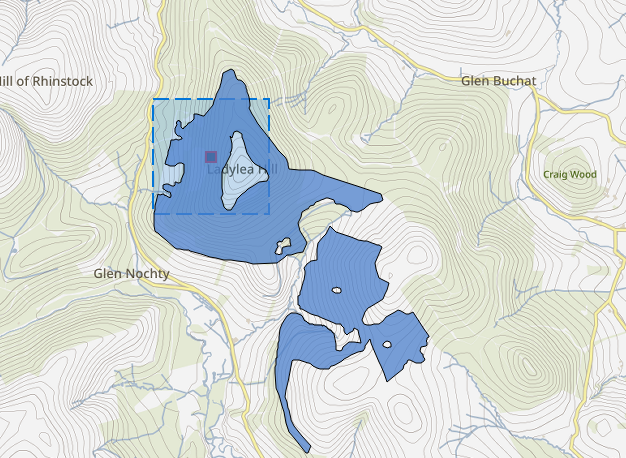
From a landscape perspective, the native woodland planting in my view looks better than either the surrounding grouse moors or the commercial forestry plantations but still raises questions about whether its fit for what is supposed to be a National Park:
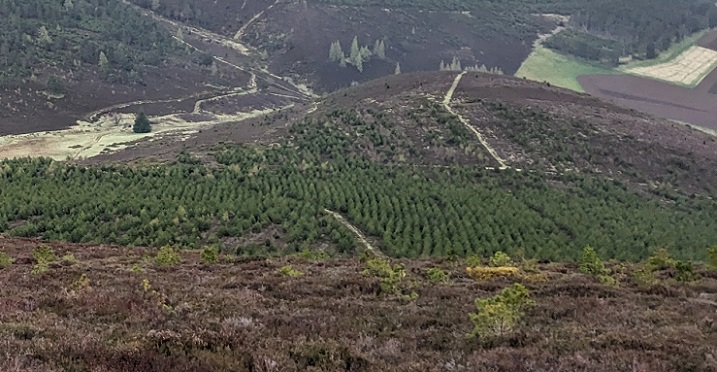
Most of the trees have been planted closely together and in rows, creating a new even-aged monoculture over much of the area. Interspersed with the native woodland planting, however, is some natural regeneration of both native and not-native trees. Hence, for example, the more varied woodland near the bottom of the glen in the photo above.
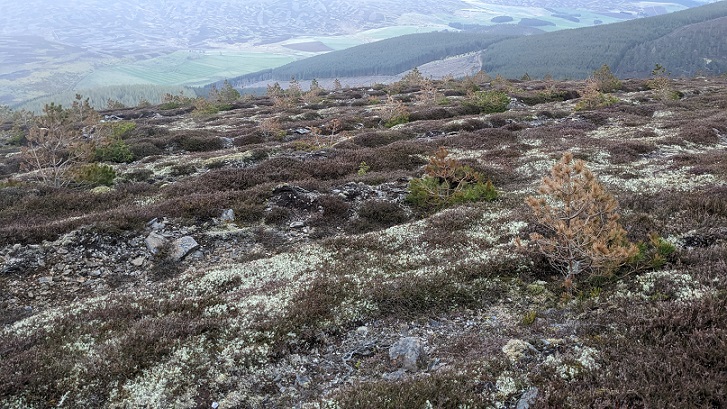
Descending from the summit slightly to the east I came across a ploughed area at c550m in altitude with lots of dead or dying Scots Pine. While there are several causes for pine needles turning brown and dying, the most common is a lack of water. Its seems therefore that these Scots Pine on Ladyhill may, just like those of BrewDog at Kinrara (see here), have been severely affected by the drought last Spring.
Being several years older, the trees on Ladylea Hill will have developed deeper roots than those at Kinrara, which would help explain why some appear to have survived – just!

The soil cover high up on this hillside was very thin, so relatively little carbon will have been released by the ploughing, but that also makes it very vulnerable to desiccation. The ploughing has exposed more ground to the drying affects of sun and wind and created new drainage lines. There is now a presumption against ploughing, at least on peat, as a means of ground preparation for tree planting but I suspect staff on the ground in Scottish Forestry must have known this was a stupid and damaging thing to do 10 years ago. The problem, just as with BrewDog’s Dead Forest, is they will have been under pressure to meet planting targets.
The wide gaps between many of the Scots Pine in the photos suggests that this may not be the first time that trees here have died off since the site was first planted c10 years ago. Much of each ploughed furrow is also still bare of plant cover, quite a contrast to the relatively undisturbed dry heath vegetation in-between which is covered with cladonia lichens. These store carbon, help create soils and are an indication low levels of grazing and trampling. Imagine what the hillside might have looked like if it had been left to nature.
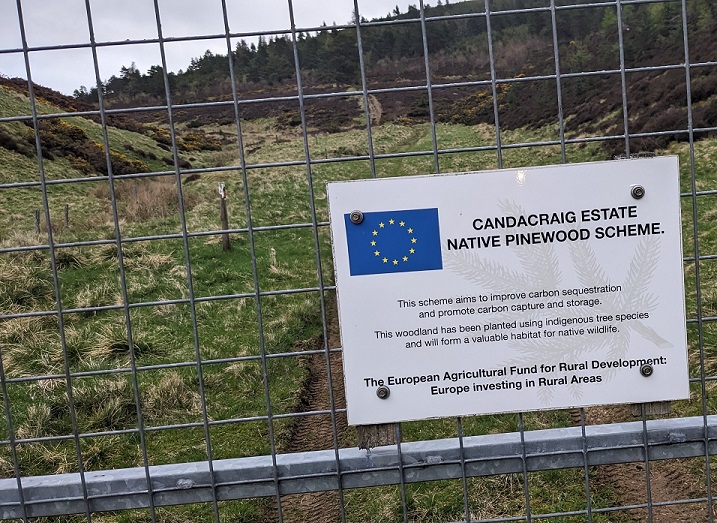
The claim on the Candacraig sign that this native woodland scheme aims to promote carbon capture and to form a valuable habitat for wildlife is one that would merit an objective scientific assessment.
There is only one entry for Candacraig that I could find on the woodland carbon registry. This is for a 2020 project called “New shoots”. with the pun in the title suggesting its a clever wheeze to make more money out of planting new woodland for pheasant shooting by selling carbon credits!. As a consequence, there is no public information available about the amount of carbon it is estimated the Ladylea Hill planting has emitted or how much might be absorbed from the atmosphere by the trees.
My observations suggest the upper part of the native woodland is likely to contribute little if anything to offsetting carbon emissions since so many of the trees have died/are dying and because those that do survive are likely to remain stunted due to the lack of water, wind etc. What one can say s that there now appears to be considerably less biomass, which stores carbon, in the ploughed area than if if it had just been left to regenerate itself.
While this native woodland planting may not have been as damaging to nature as the industrial forestry or intensive grouse moor management nearby, I could see very little evidence that it has had any positive impacts. The only wildlife I spotted or heard were roe deer bouncing through the trees lower down.
One wonders whether the Cairngorms National Park Authority (CNPA) ever questioned the alleged benefits for nature when this scheme was first mooted? Unfortunately I suspect their staff, like those in Scottish Forestry, have been under constant pressure to meet woodland expansion targets through planting, whatever their own views of the costs and benefits.
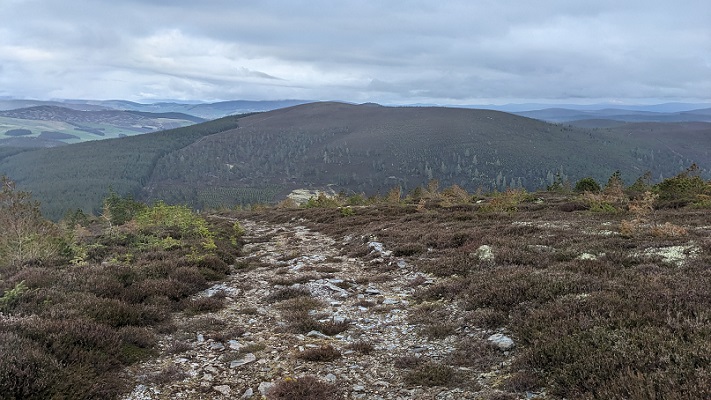
It was notable that self-seeded sitka appeared to be doing better than the planted Scots Pine in several places. This provides more evidence that woodland expansion targets could be met through natural regeneration rather than planting:
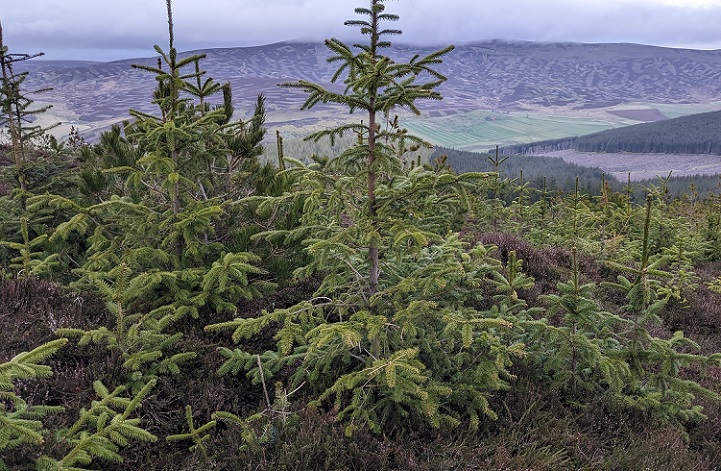
The challenge for this project and native woodland in the National Park as a whole is that Sitka is the wrong species of tree!
Discussion
The way the land around Donside is being managed raises some fundamental questions about what the CNPA, whose statutory aims including conservation of the natural heritage, wise use of resources and sustainable development is actually doing to make a difference?
The evidence for the damage done by native tree planting when the soil is cultivated is steadily increasing: it releases carbon into the atmosphere and is often bad for nature. It is now also becoming apparent that such planting has a very high failure rate and is therefore, where paid for by grants, a total waste of public money.
In response to the media coverage of the planting disaster at Kinrara, BrewDog belatedly started this spring to replace some of the trees in their dead forest (see here for coverage in the National in which I was pleased to be quoted). BrewDog should have started doing that much earlier in the year but, with spring being generally far wetter than last, it is possible that more of BrewDog’s replacement trees will survive than the originals – for a time at least! What Ladylea Hill suggests, however, is that the long-term long-term prognosis for native tree survival in carbon offsetting projects which use ploughing or mounding on shallow hills is likely to be very poor. Young trees may now have to contend with several droughts, a fact which should help drive a ban on the use of forestry techniques designed to drain the soil.
Unfortunately, Scottish Forestry only monitors native woodland planting projects for the first five years and, as I have found through FOI requests, throws out older records. This makes research into whether these native woodland grants schemes have met public policy objectives in the medium to longer term particularly challenging. However, the evidence on the ground (which I will write more about in due course) is that whether because of drought or grazing pressure the outcomes of a high proportion of these schemes are very poor.

The CNPA, which has a policy of supporting natural regeneration, could start take a stand and oppose ALL native woodland projects which use planting techniques because of the carbon emissions this causes and the high likelihood of failure.
How to manage woodland in places like Ladylea Hill does, however, create some dilemmas. While the creation of native woodland, a valuable habitat, should in my view by natural regeneration, that might well not have happened here. The problem is not that there is no seed source for Scots Pine: there is. The problem is the super-abundant seed source for Sitka from the nearby plantations: this had already, in less than ten years, started turning parts of Ladylea Hill which were formerly grouse moor into mixed woodland.
While Sitka is more resistant to grazing than Scots Pine and grows faster, so it could within a few years shade it out, Scots Pine is better adapted to dry conditions such as those high up on Ladylea Hill. The outcome of this competition, if left to nature, will be interesting.
The CNPA, one of whose objectives is to expand native woodland, could try and influence the competition by pressing for grant support to shift from planting Scots Pine to weeding out non-native Sitka saplings each year, an expensive option. An alternative approach, however, would be to abandon attempts to create patches of pure native woodland in areas like this and use natural regeneration by both non-native and non-native trees to create a new model of mixed woodland as as Jim Knight advocated in his excellent 2019 policy paper for Reforesting Scotland, “A Forest for the Future” (see here).
Interestingly, the Candacraig Estate appears to have started going down that line after Storm Arwen blew down parts of its large blocks of Sitka. Rather than simply replant Sitka, Candacraig decided to start trialing how it could diversify its commercial woodland, partly as a defence against disease and pests, and move towards a model of continuous cover forestry/”Low Impact Silvicultural Systems” as practised on the continent. There is an informative blog about this on the website (see here) of the Royal Forestry Society who helped fund the trial with a “resilience grant”. There is no mention as to whether the CNPA was involved.
Both our National Parks have had a blind spot when it comes to improving forestry practice whether in relation to commercial forestry or native woodland. What Candacraig is trialing is the sort of initiative our National parks should be promoting on a much bigger scale, particularly in the Loch Lomond and Trossachs where much hill land is dominated by Sitka plantations.
Before that happens, however, both the Scottish Government and its agencies need to be clear that mixed woodland of native and non-native trees is not appropriate everywhere, for example in places like Kinrara or around important fragments of Caledonian Pine Forest. In those areas the focus of public agencies should be directed towards weeding out/preventing the spread of non-native species. In areas like Donside, however, which in my view are so trashed that it will be very difficult for them ever to achieve the core conservation objective of National Parks, continuous cover forestry would be a significant step forward.
Zoning would be required to enable such an approach to forest management to work. Before the National Park (Scotland) Act most of those involved in advocating for the new legislation assumed that zoning would be integral to their future:
- core zones, refuges for native species and areas where natural processes would predominate (e.g the whole of the central Cairngorms and Lochnagar massifs);
- peripheral zones, areas where there would be public support for nature friendly productive land-uses including farming and forestry (e.g much of Donside); and
- more developed zones, including settlements.
Such a zoning approach could be used to set basic rules for how natural regeneration of trees and woodland in our National Parks should be managed and help address the issues raised in this post:
- core zones, no planting, public support for weeding out non-native species;
- peripheral zones, continuous cover forestry/mixed woodland model, no planting allowed that involves ploughing or mounding or other forms of significant soil disturbance (planting by screefing, the clearance of vegetation, would be allowed);
- developed zones, planting allowed but strict controls to prevent introduction of invasive species

Hi there i am the gamekeeper on candacraig estate and have been involved the the management of the ladylee project from day one you state there is only one access gate i can assure you that that there is 8 access gates into the planting for easy public access and the planting is not used for pheasant shooting apart from the gate at invernettie where you want in thats where the guns always stood before it was a planting. As for the dying trees on top of ladylee and clashintepal we have been monitoring the for 5yrs now some did dye off when others did recover but as you will have noticed it’s more down to being wind clip damage and there’s nothing that can be done for that and the non native trees are a problem i was hand pulling at the start of the project but proved to be pointless i did have concerns about the scarifiying on the hill for planting the tree’s and put forward to the landowner and did take on board and did agree with me on the wildlife front we have a high density of bird life from golden plover crossbills medow pipets white tailed eagles and golden eagles goshawks buzzards the list could go on and on sadly i am retiring very soon
and i will just be a bystander
Hi Ian, your comment as someone who has been involved is really appreciated and interesting. I guess the point is that whether drought or windclip there are serious questions to be asked about why Scottish Forestry is allowing estates to plant trees like this high up? Its not your or the landowners fault, Scottish Forestry should know. I have re-read post and cannot see anywhere I stated there is only one access point – just to be clear at no point did I see anything that might have discouraged access and I welcome your welcome to walkers.
I will never stop finding it amazing that the schemes continue even when we know how a vegetation succession works, you can’t just go from heather moor to pine forest straight away, you’ve got to let a lot of natural regeneration happen, so reduce overgrazing around already present native woodland and letting it expand, this is a fairly basic concept in botany and environmental science so why do they instead plant massive monocultures is beyond me, besides trying to reach that tree planting goal of course because green washing is the only way forward apparently.
Really interesting read, thanks!
Will mixed woodland be sustainably mixed near Sitka plantations as Sitka will dominate and eventually take over.
Also noticed the claim of only one access point.
On the continent foresters tend not to plant trees and leave it to natural regeneration – that results in minimal soil disturbance, emission of carbon etc – but they do then manage these mixed forests for productive purposes felling trees that are not required. While generally that is done for timber production purposes it can also be done to maintain species diversity. If Ladylea Hill is left to nature it would well end up as all Sitka. However, if instead if was treated as mixed productive woodland, Sitka could be prevented from dominating. Rather than the gamekeeper vainly trying to pull out sitka seedlings, they could be removing some of them when bigger. In relation to the access point, I think you have misunderstood what I wrote “There is only one entry for Candacraig that I could find on the woodland carbon registry” – that was about entries to the carbon code data base not about access points!
I also believe zoning of land would support better decision making and more sustainable new woodlands in the uplands. There is an existing system known as the Land Capability for Forestry Classification, developed by the Macaulay Land Use Research Institute in Aberdeen (now part of John Hutton Institute). Linking biophysical conditions to woodland potential the LCF could easily contribute to zoning. I have previously suggested that natural regeneration of native species should be favoured exclusively under the various grant schemes on LCF classes 6 and 7 (the toughest environments for trees). Sitka spruce and more generally, ‘planting with cultivation’ should be restricted to LCF classes 5 and less, which is largely land that has, in the past, been managed for farming